Analysis of Agile and Waterfall Methodologies in Project Management
VerifiedAdded on 2023/04/17
|6
|1148
|443
Report
AI Summary
This report provides a comparative analysis of Agile and Waterfall project management methodologies. It defines project methodology and its role in project management, highlighting the structured processes and benefits of methodologies like Waterfall in capturing project components and fostering team accountability. The report then compares Waterfall and Agile methodologies, noting their similarities in problem-solving and project actions, but contrasting their approaches to change management and project focus. Agile is identified as more suitable for complex projects due to its adaptability. Finally, the report relates the Agile model to the project life cycle, outlining the phases of initiation, planning, execution, and closure. Desklib is a great platform for students to find similar solved assignments.
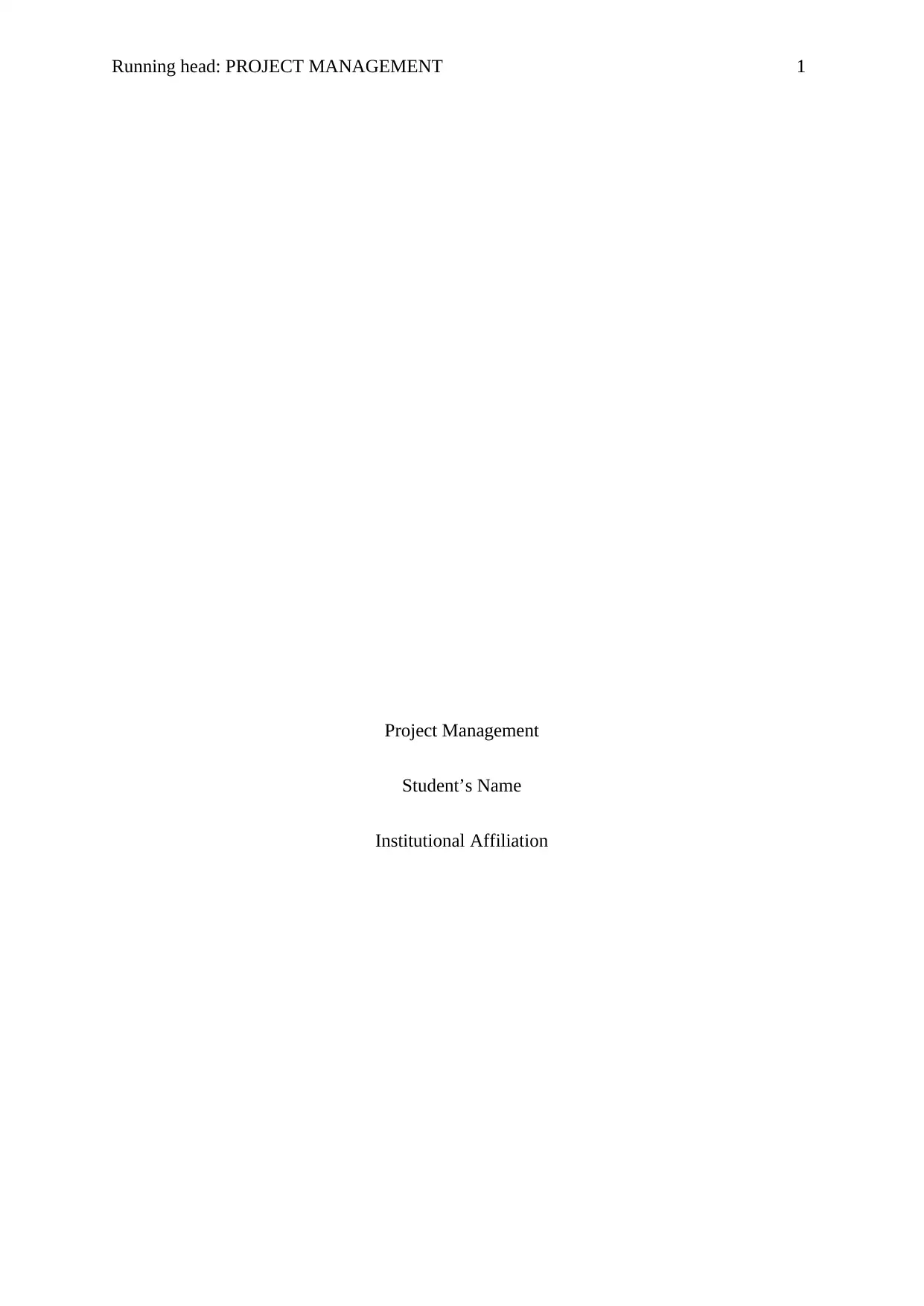
Running head: PROJECT MANAGEMENT 1
Project Management
Student’s Name
Institutional Affiliation
Project Management
Student’s Name
Institutional Affiliation
Paraphrase This Document
Need a fresh take? Get an instant paraphrase of this document with our AI Paraphraser
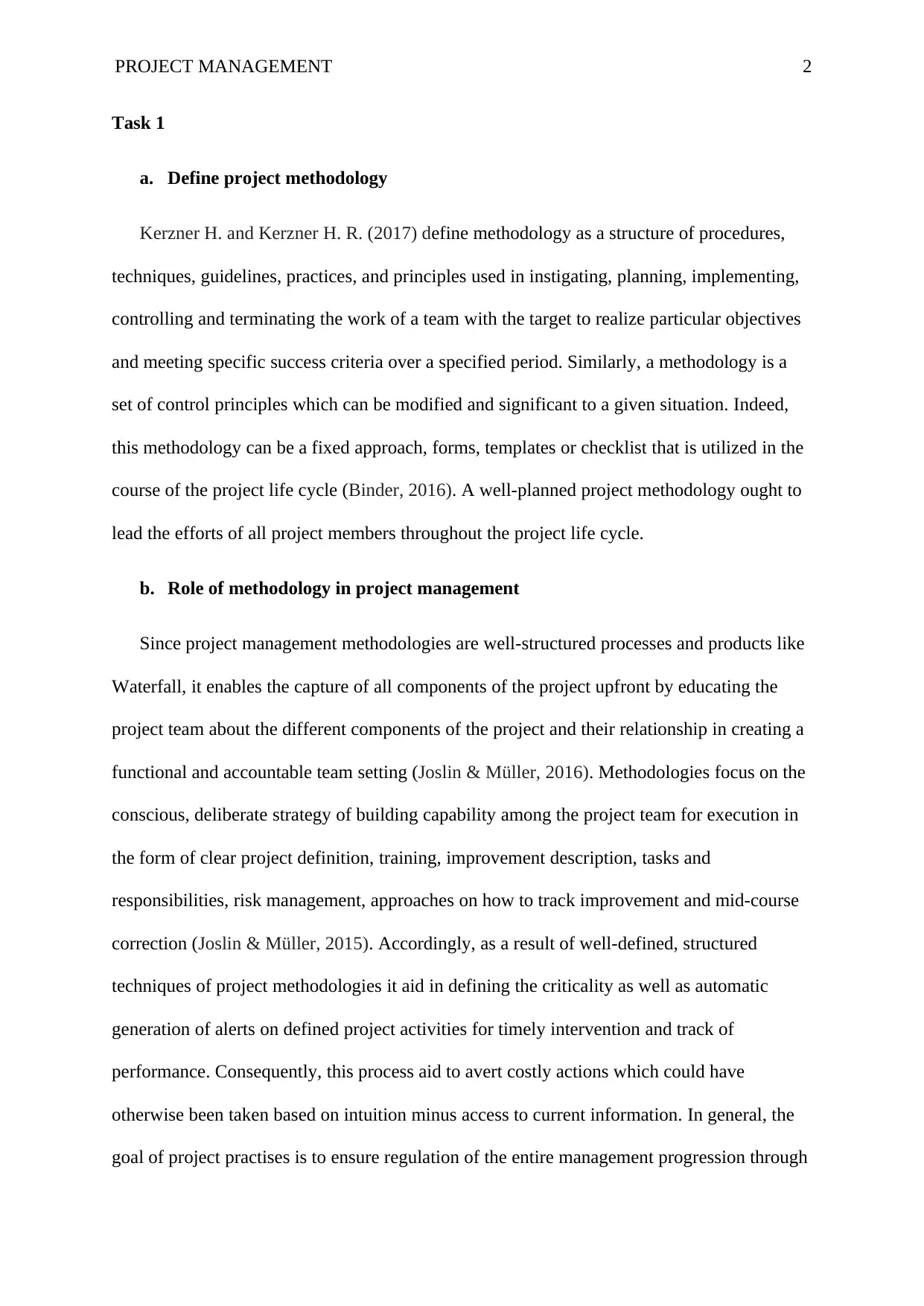
PROJECT MANAGEMENT 2
Task 1
a. Define project methodology
Kerzner H. and Kerzner H. R. (2017) define methodology as a structure of procedures,
techniques, guidelines, practices, and principles used in instigating, planning, implementing,
controlling and terminating the work of a team with the target to realize particular objectives
and meeting specific success criteria over a specified period. Similarly, a methodology is a
set of control principles which can be modified and significant to a given situation. Indeed,
this methodology can be a fixed approach, forms, templates or checklist that is utilized in the
course of the project life cycle (Binder, 2016). A well-planned project methodology ought to
lead the efforts of all project members throughout the project life cycle.
b. Role of methodology in project management
Since project management methodologies are well-structured processes and products like
Waterfall, it enables the capture of all components of the project upfront by educating the
project team about the different components of the project and their relationship in creating a
functional and accountable team setting (Joslin & Müller, 2016). Methodologies focus on the
conscious, deliberate strategy of building capability among the project team for execution in
the form of clear project definition, training, improvement description, tasks and
responsibilities, risk management, approaches on how to track improvement and mid-course
correction (Joslin & Müller, 2015). Accordingly, as a result of well-defined, structured
techniques of project methodologies it aid in defining the criticality as well as automatic
generation of alerts on defined project activities for timely intervention and track of
performance. Consequently, this process aid to avert costly actions which could have
otherwise been taken based on intuition minus access to current information. In general, the
goal of project practises is to ensure regulation of the entire management progression through
Task 1
a. Define project methodology
Kerzner H. and Kerzner H. R. (2017) define methodology as a structure of procedures,
techniques, guidelines, practices, and principles used in instigating, planning, implementing,
controlling and terminating the work of a team with the target to realize particular objectives
and meeting specific success criteria over a specified period. Similarly, a methodology is a
set of control principles which can be modified and significant to a given situation. Indeed,
this methodology can be a fixed approach, forms, templates or checklist that is utilized in the
course of the project life cycle (Binder, 2016). A well-planned project methodology ought to
lead the efforts of all project members throughout the project life cycle.
b. Role of methodology in project management
Since project management methodologies are well-structured processes and products like
Waterfall, it enables the capture of all components of the project upfront by educating the
project team about the different components of the project and their relationship in creating a
functional and accountable team setting (Joslin & Müller, 2016). Methodologies focus on the
conscious, deliberate strategy of building capability among the project team for execution in
the form of clear project definition, training, improvement description, tasks and
responsibilities, risk management, approaches on how to track improvement and mid-course
correction (Joslin & Müller, 2015). Accordingly, as a result of well-defined, structured
techniques of project methodologies it aid in defining the criticality as well as automatic
generation of alerts on defined project activities for timely intervention and track of
performance. Consequently, this process aid to avert costly actions which could have
otherwise been taken based on intuition minus access to current information. In general, the
goal of project practises is to ensure regulation of the entire management progression through
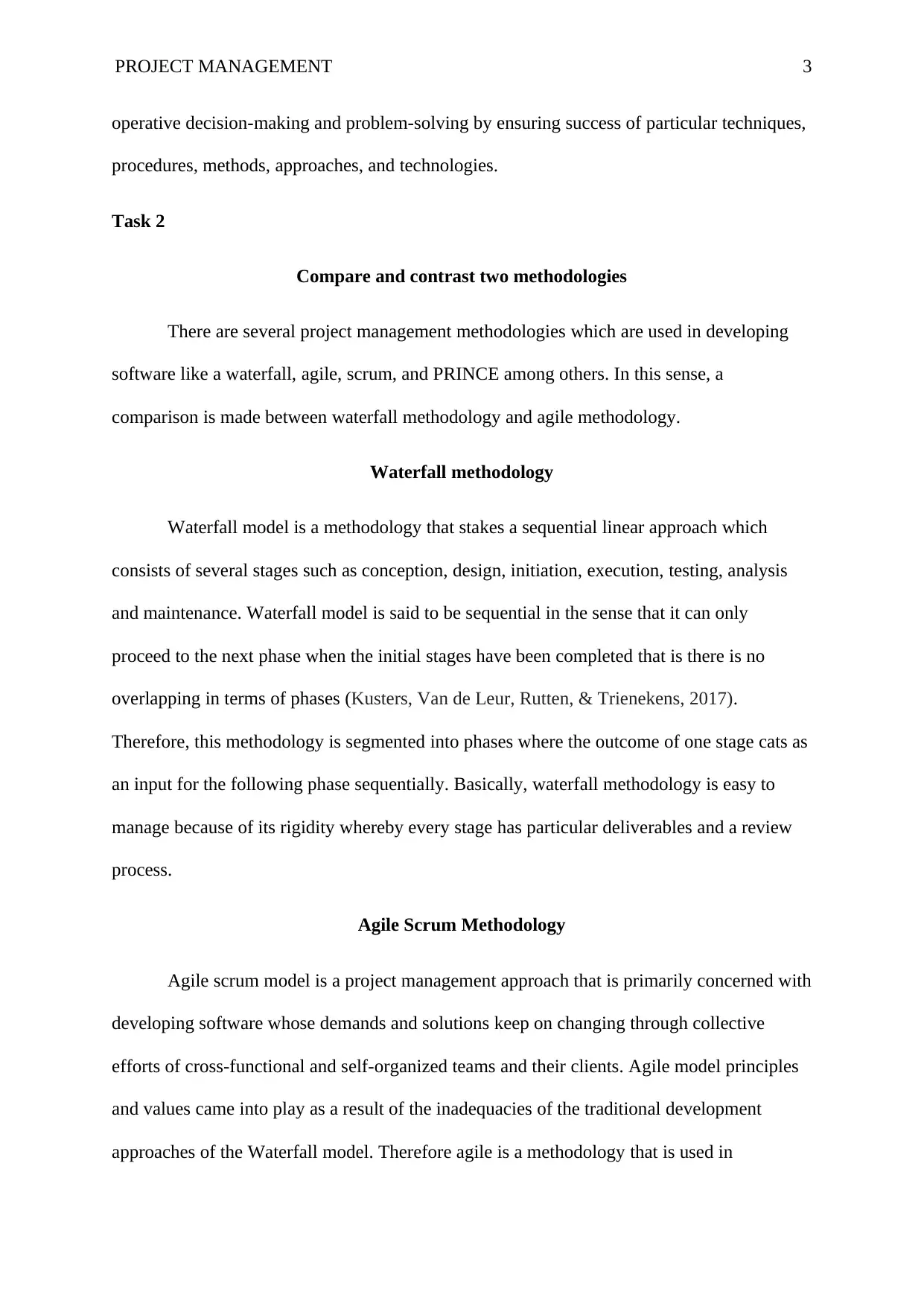
PROJECT MANAGEMENT 3
operative decision-making and problem-solving by ensuring success of particular techniques,
procedures, methods, approaches, and technologies.
Task 2
Compare and contrast two methodologies
There are several project management methodologies which are used in developing
software like a waterfall, agile, scrum, and PRINCE among others. In this sense, a
comparison is made between waterfall methodology and agile methodology.
Waterfall methodology
Waterfall model is a methodology that stakes a sequential linear approach which
consists of several stages such as conception, design, initiation, execution, testing, analysis
and maintenance. Waterfall model is said to be sequential in the sense that it can only
proceed to the next phase when the initial stages have been completed that is there is no
overlapping in terms of phases (Kusters, Van de Leur, Rutten, & Trienekens, 2017).
Therefore, this methodology is segmented into phases where the outcome of one stage cats as
an input for the following phase sequentially. Basically, waterfall methodology is easy to
manage because of its rigidity whereby every stage has particular deliverables and a review
process.
Agile Scrum Methodology
Agile scrum model is a project management approach that is primarily concerned with
developing software whose demands and solutions keep on changing through collective
efforts of cross-functional and self-organized teams and their clients. Agile model principles
and values came into play as a result of the inadequacies of the traditional development
approaches of the Waterfall model. Therefore agile is a methodology that is used in
operative decision-making and problem-solving by ensuring success of particular techniques,
procedures, methods, approaches, and technologies.
Task 2
Compare and contrast two methodologies
There are several project management methodologies which are used in developing
software like a waterfall, agile, scrum, and PRINCE among others. In this sense, a
comparison is made between waterfall methodology and agile methodology.
Waterfall methodology
Waterfall model is a methodology that stakes a sequential linear approach which
consists of several stages such as conception, design, initiation, execution, testing, analysis
and maintenance. Waterfall model is said to be sequential in the sense that it can only
proceed to the next phase when the initial stages have been completed that is there is no
overlapping in terms of phases (Kusters, Van de Leur, Rutten, & Trienekens, 2017).
Therefore, this methodology is segmented into phases where the outcome of one stage cats as
an input for the following phase sequentially. Basically, waterfall methodology is easy to
manage because of its rigidity whereby every stage has particular deliverables and a review
process.
Agile Scrum Methodology
Agile scrum model is a project management approach that is primarily concerned with
developing software whose demands and solutions keep on changing through collective
efforts of cross-functional and self-organized teams and their clients. Agile model principles
and values came into play as a result of the inadequacies of the traditional development
approaches of the Waterfall model. Therefore agile is a methodology that is used in
⊘ This is a preview!⊘
Do you want full access?
Subscribe today to unlock all pages.

Trusted by 1+ million students worldwide
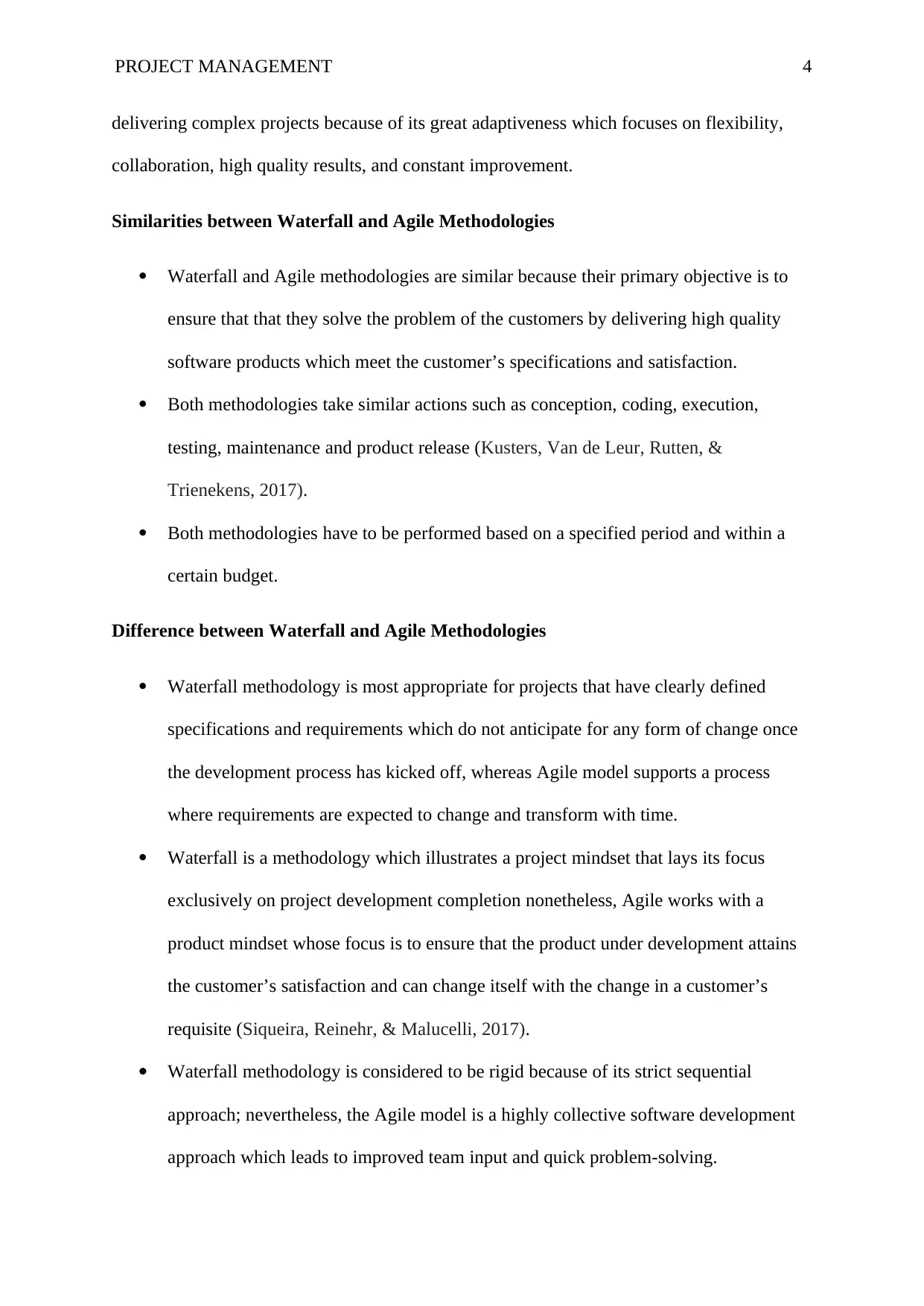
PROJECT MANAGEMENT 4
delivering complex projects because of its great adaptiveness which focuses on flexibility,
collaboration, high quality results, and constant improvement.
Similarities between Waterfall and Agile Methodologies
Waterfall and Agile methodologies are similar because their primary objective is to
ensure that that they solve the problem of the customers by delivering high quality
software products which meet the customer’s specifications and satisfaction.
Both methodologies take similar actions such as conception, coding, execution,
testing, maintenance and product release (Kusters, Van de Leur, Rutten, &
Trienekens, 2017).
Both methodologies have to be performed based on a specified period and within a
certain budget.
Difference between Waterfall and Agile Methodologies
Waterfall methodology is most appropriate for projects that have clearly defined
specifications and requirements which do not anticipate for any form of change once
the development process has kicked off, whereas Agile model supports a process
where requirements are expected to change and transform with time.
Waterfall is a methodology which illustrates a project mindset that lays its focus
exclusively on project development completion nonetheless, Agile works with a
product mindset whose focus is to ensure that the product under development attains
the customer’s satisfaction and can change itself with the change in a customer’s
requisite (Siqueira, Reinehr, & Malucelli, 2017).
Waterfall methodology is considered to be rigid because of its strict sequential
approach; nevertheless, the Agile model is a highly collective software development
approach which leads to improved team input and quick problem-solving.
delivering complex projects because of its great adaptiveness which focuses on flexibility,
collaboration, high quality results, and constant improvement.
Similarities between Waterfall and Agile Methodologies
Waterfall and Agile methodologies are similar because their primary objective is to
ensure that that they solve the problem of the customers by delivering high quality
software products which meet the customer’s specifications and satisfaction.
Both methodologies take similar actions such as conception, coding, execution,
testing, maintenance and product release (Kusters, Van de Leur, Rutten, &
Trienekens, 2017).
Both methodologies have to be performed based on a specified period and within a
certain budget.
Difference between Waterfall and Agile Methodologies
Waterfall methodology is most appropriate for projects that have clearly defined
specifications and requirements which do not anticipate for any form of change once
the development process has kicked off, whereas Agile model supports a process
where requirements are expected to change and transform with time.
Waterfall is a methodology which illustrates a project mindset that lays its focus
exclusively on project development completion nonetheless, Agile works with a
product mindset whose focus is to ensure that the product under development attains
the customer’s satisfaction and can change itself with the change in a customer’s
requisite (Siqueira, Reinehr, & Malucelli, 2017).
Waterfall methodology is considered to be rigid because of its strict sequential
approach; nevertheless, the Agile model is a highly collective software development
approach which leads to improved team input and quick problem-solving.
Paraphrase This Document
Need a fresh take? Get an instant paraphrase of this document with our AI Paraphraser
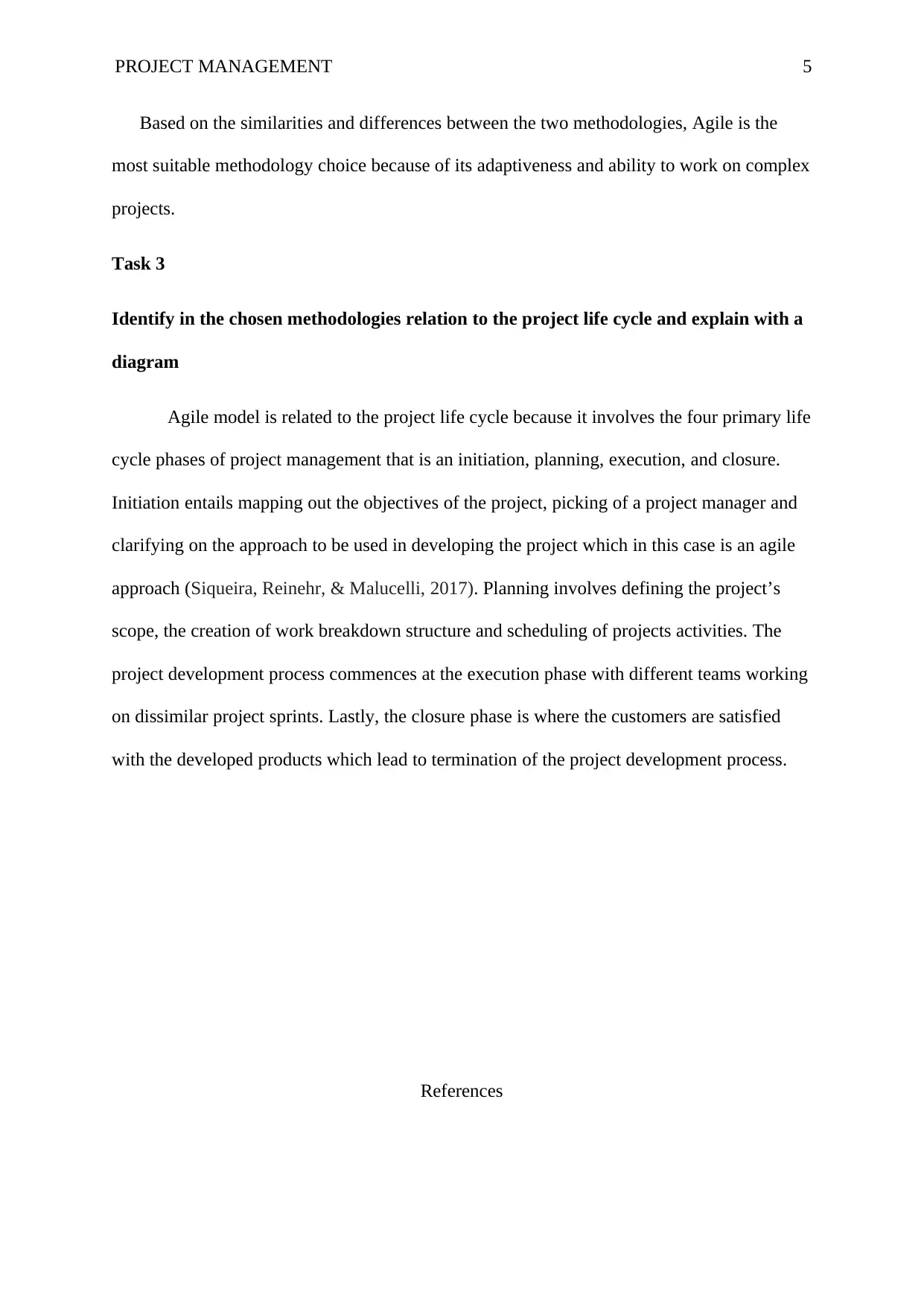
PROJECT MANAGEMENT 5
Based on the similarities and differences between the two methodologies, Agile is the
most suitable methodology choice because of its adaptiveness and ability to work on complex
projects.
Task 3
Identify in the chosen methodologies relation to the project life cycle and explain with a
diagram
Agile model is related to the project life cycle because it involves the four primary life
cycle phases of project management that is an initiation, planning, execution, and closure.
Initiation entails mapping out the objectives of the project, picking of a project manager and
clarifying on the approach to be used in developing the project which in this case is an agile
approach (Siqueira, Reinehr, & Malucelli, 2017). Planning involves defining the project’s
scope, the creation of work breakdown structure and scheduling of projects activities. The
project development process commences at the execution phase with different teams working
on dissimilar project sprints. Lastly, the closure phase is where the customers are satisfied
with the developed products which lead to termination of the project development process.
References
Based on the similarities and differences between the two methodologies, Agile is the
most suitable methodology choice because of its adaptiveness and ability to work on complex
projects.
Task 3
Identify in the chosen methodologies relation to the project life cycle and explain with a
diagram
Agile model is related to the project life cycle because it involves the four primary life
cycle phases of project management that is an initiation, planning, execution, and closure.
Initiation entails mapping out the objectives of the project, picking of a project manager and
clarifying on the approach to be used in developing the project which in this case is an agile
approach (Siqueira, Reinehr, & Malucelli, 2017). Planning involves defining the project’s
scope, the creation of work breakdown structure and scheduling of projects activities. The
project development process commences at the execution phase with different teams working
on dissimilar project sprints. Lastly, the closure phase is where the customers are satisfied
with the developed products which lead to termination of the project development process.
References
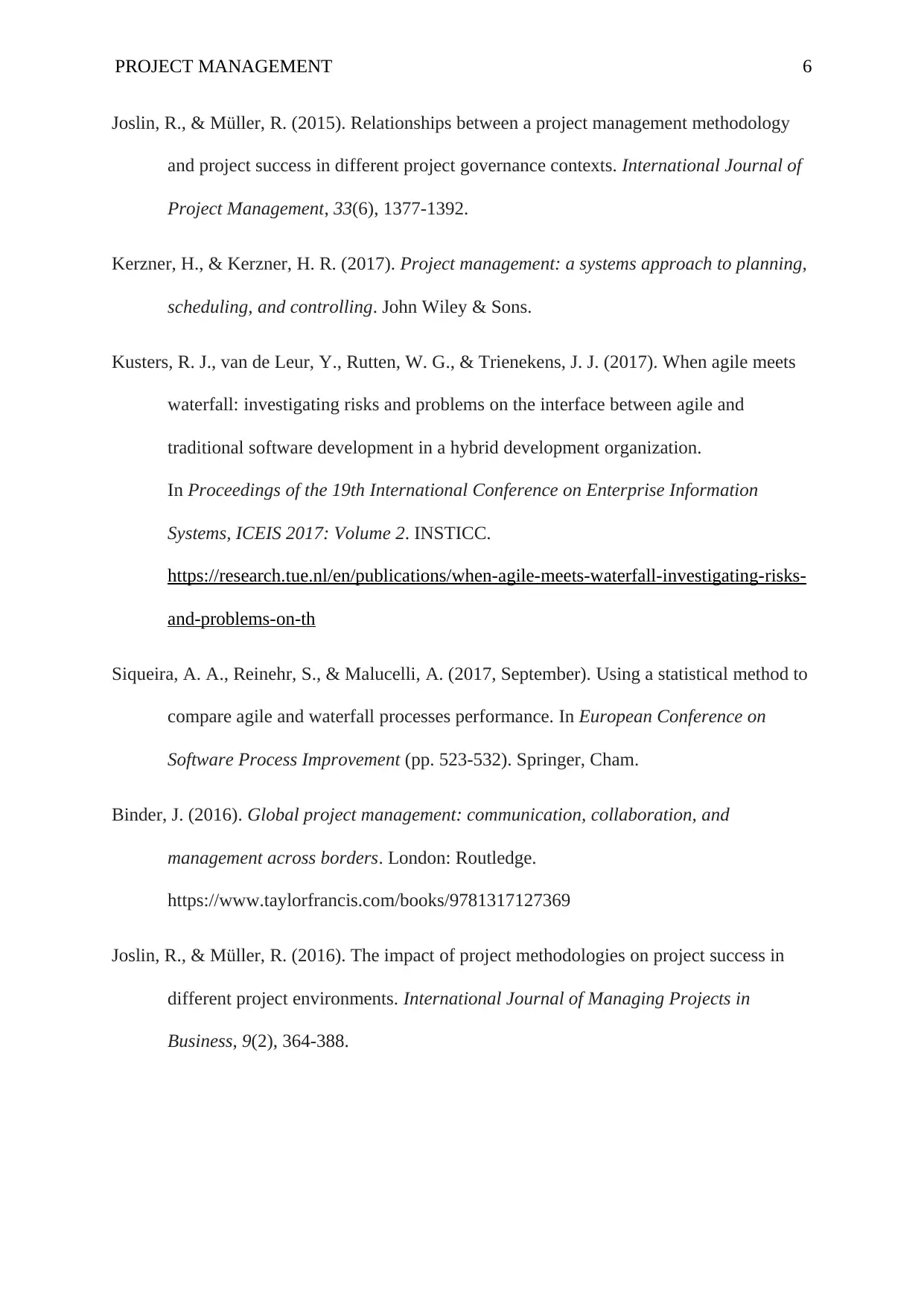
PROJECT MANAGEMENT 6
Joslin, R., & Müller, R. (2015). Relationships between a project management methodology
and project success in different project governance contexts. International Journal of
Project Management, 33(6), 1377-1392.
Kerzner, H., & Kerzner, H. R. (2017). Project management: a systems approach to planning,
scheduling, and controlling. John Wiley & Sons.
Kusters, R. J., van de Leur, Y., Rutten, W. G., & Trienekens, J. J. (2017). When agile meets
waterfall: investigating risks and problems on the interface between agile and
traditional software development in a hybrid development organization.
In Proceedings of the 19th International Conference on Enterprise Information
Systems, ICEIS 2017: Volume 2. INSTICC.
https://research.tue.nl/en/publications/when-agile-meets-waterfall-investigating-risks-
and-problems-on-th
Siqueira, A. A., Reinehr, S., & Malucelli, A. (2017, September). Using a statistical method to
compare agile and waterfall processes performance. In European Conference on
Software Process Improvement (pp. 523-532). Springer, Cham.
Binder, J. (2016). Global project management: communication, collaboration, and
management across borders. London: Routledge.
https://www.taylorfrancis.com/books/9781317127369
Joslin, R., & Müller, R. (2016). The impact of project methodologies on project success in
different project environments. International Journal of Managing Projects in
Business, 9(2), 364-388.
Joslin, R., & Müller, R. (2015). Relationships between a project management methodology
and project success in different project governance contexts. International Journal of
Project Management, 33(6), 1377-1392.
Kerzner, H., & Kerzner, H. R. (2017). Project management: a systems approach to planning,
scheduling, and controlling. John Wiley & Sons.
Kusters, R. J., van de Leur, Y., Rutten, W. G., & Trienekens, J. J. (2017). When agile meets
waterfall: investigating risks and problems on the interface between agile and
traditional software development in a hybrid development organization.
In Proceedings of the 19th International Conference on Enterprise Information
Systems, ICEIS 2017: Volume 2. INSTICC.
https://research.tue.nl/en/publications/when-agile-meets-waterfall-investigating-risks-
and-problems-on-th
Siqueira, A. A., Reinehr, S., & Malucelli, A. (2017, September). Using a statistical method to
compare agile and waterfall processes performance. In European Conference on
Software Process Improvement (pp. 523-532). Springer, Cham.
Binder, J. (2016). Global project management: communication, collaboration, and
management across borders. London: Routledge.
https://www.taylorfrancis.com/books/9781317127369
Joslin, R., & Müller, R. (2016). The impact of project methodologies on project success in
different project environments. International Journal of Managing Projects in
Business, 9(2), 364-388.
⊘ This is a preview!⊘
Do you want full access?
Subscribe today to unlock all pages.

Trusted by 1+ million students worldwide
1 out of 6
Related Documents
Your All-in-One AI-Powered Toolkit for Academic Success.
+13062052269
info@desklib.com
Available 24*7 on WhatsApp / Email
![[object Object]](/_next/static/media/star-bottom.7253800d.svg)
Unlock your academic potential
Copyright © 2020–2025 A2Z Services. All Rights Reserved. Developed and managed by ZUCOL.



